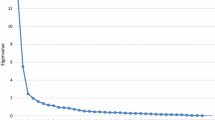Abstract
The present study reports the psychometric properties of the Inventory of Statements About Self-injury (ISAS), a measure designed to comprehensively assess the functions of non-suicidal self-injury (NSSI). The ISAS assesses 13 functions of NSSI, as well as the frequency of 12 NSSI behaviors. The ISAS was administered to 235 young adults from a college population who had performed at least one NSSI behavior. Consistent with previous research, ISAS functions comprised two factors representing interpersonal and intrapersonal functions. In addition, the ISAS factors exhibited excellent internal consistency and expected correlations with both clinical constructs (e.g., borderline personality disorder, suicidality, depression, anxiety) and contextual variables (e.g., tendency to self-injure alone). Findings support the reliability and validity of the ISAS. The ISAS may be useful in research and treatment contexts as a comprehensive measure of NSSI functions.
Similar content being viewed by others
References
Brenner, N. D., Kann, L., Mcmanus, S. A., et al. (2002). Reliability of the 1999 youth risk behavior survey questionnaire. Journal of Adolescent Health, 31, 336–342.
Gratz, K. L. (2001). Measurement of deliberate self-harm: Preliminary data on the Deliberate Self-Harm Inventory. Journal of Psychopathology and Behavioral Assessment, 23, 253–263.
Henry, J. D., & Crawford, J. R. (2005). The short-form version of the Depression Anxiety Stress Scales (DASS-21): Construct validity and normative data in a large non-clinical sample. British Journal of Clinical Psychology, 44, 227–239.
Jacobson, C. M., & Gould, M. (2007). The epidemiology and phenomenology of non-suicidal self-injurious behavior among adolescents: A critical review of the literature. Archives of Suicide Research, 11, 129–147.
Kann, L. (2001). The Youth Risk Behavior Surveillance System: Measuring health-risk behaviors. American Journal of Health Behavior, 25, 272–277.
Klonsky, E. D. (2007). The functions of deliberate self-injury: A review of the evidence. Clinical Psychology Review, 27, 226–239.
Klonsky, E. D. (in press). The functions of self-injury in young adults who cut themselves: clarifying the evidence for affect-regulation. Psychiatry Research.
Klonsky, E. D., & Glenn, C. R. (2008). Psychosocial risk and protective factors. In M. K. Nixon, & N. Heath (Eds.), Self-injury in youth: The essential guide to assessment and intervention. New York, NY: Routledge.
Klonsky, E. D., & Olino, T. M. (2008). Identifying clinically distinct subgroups of self-injurers among young adults: A latent class analysis. Journal of Consulting and Clinical Psychology, 76, 22–27.
Klonsky, E. D., Oltmanns, T. F., & Turkheimer, E. (2003). Deliberate self-harm in a nonclinical population: Prevalence and psychological correlates. American Journal of Psychiatry, 160, 1501–1508.
Klonsky, E. D. & Weinberg, A. (in press). Assessment of non-suicidal self-injury. In. M.K. Nock (Ed.)., Understanding non-suicidal self-injury: Origins, assessment, and treatment. American Psychological Association Press.
Kress, V. E. W. (2003). Self-injurious behaviors: Assessment and diagnosis. Journal of Counseling and Development, 81, 490–496.
Muehlenkamp, J. J. (2006). Empirically supported treatments and general therapy guidelines for non-suicidal self-injury. Journal of Mental Health Counseling, 28, 166–185.
Lloyd, E. E., Kelley, M. L., & Hope, T. (1997). Self-mutilation in a community sample of adolescents: Descriptive characteristics and provisional prevalence rates. Poster presented at the annual meeting of the Society for Behavioral Medicine. New Orleans: LA.
Nock, M. K., Holmberg, E. B., Photos, V. I., & Michel, B. D. (2007). Self-Injurious Thoughts and Behaviors Interview: Development, reliability, and validity in an adolescent sample. Psychological Assessment, 19, 309–317.
Nock, M. K., Joiner, T. E., Gordon, K. H., Lloyd-Richardson, E., & Prinstein, M. (2006). Non-suicidal self-injury among adolescents: Diagnostic correlates and relation to suicide attempts. Psychiatry Research, 144, 65–72.
Nock, M. K., & Prinstein, M. J. (2004). A functional approach to the assessment of self-mutilative behavior. Journal of Consulting and Clinical Psychology, 72, 885–890.
Nock, M. K., & Prinstein, M. J. (2005). Contextual features and behavioral functions of self-mutilation among adolescents. Journal of Abnormal Psychology, 114, 140–146.
Rodham, K., Hawton, K., & Evans, E. (2004). Reasons for deliberate self-harm: Comparison of self-poisoners and self-cutters in a community sample of adolescents. Journal of the American Academy of Child and Adolescent Psychiatry, 43, 80–87.
Ross, S., & Heath, N. (2002). A study of the frequency of self-mutilation in a community sample of adolescents. Journal of Youth and Adolescence, 31, 67–77.
Whitlock, J., Eckenrode, J., & Silverman, D. (2006). Self-injurious behaviors in a college population. Pediatrics, 117, 1939–1948.
Whitlock, J., & Knox, K. L. (2007). The relationship between self-injurious behavior and suicide in a young adult population. Archives of Pediatrics and Adolescent Medicine, 161, 634–640.
Zanarini, M. C., Vujanovic, A., Parachini, E. A., Boulanger, J. L., Frankenburg, F. R., & Hennen, J. (2003). A screening measure for BPD: The Mclean Screening Instrument for Borderline Personality Disorder. Journal of Personality Disorders, 17, 568–573.
Acknowledgement
This work was supported in part by the Office of the Vice President of Research at Stony Brook University and grant MH080096 from the National Institute of Mental Health.
Author information
Authors and Affiliations
Corresponding author
Appendix
Appendix
Rights and permissions
About this article
Cite this article
Klonsky, E.D., Glenn, C.R. Assessing the Functions of Non-suicidal Self-injury: Psychometric Properties of the Inventory of Statements About Self-injury (ISAS). J Psychopathol Behav Assess 31, 215–219 (2009). https://doi.org/10.1007/s10862-008-9107-z
Published:
Issue Date:
DOI: https://doi.org/10.1007/s10862-008-9107-z




